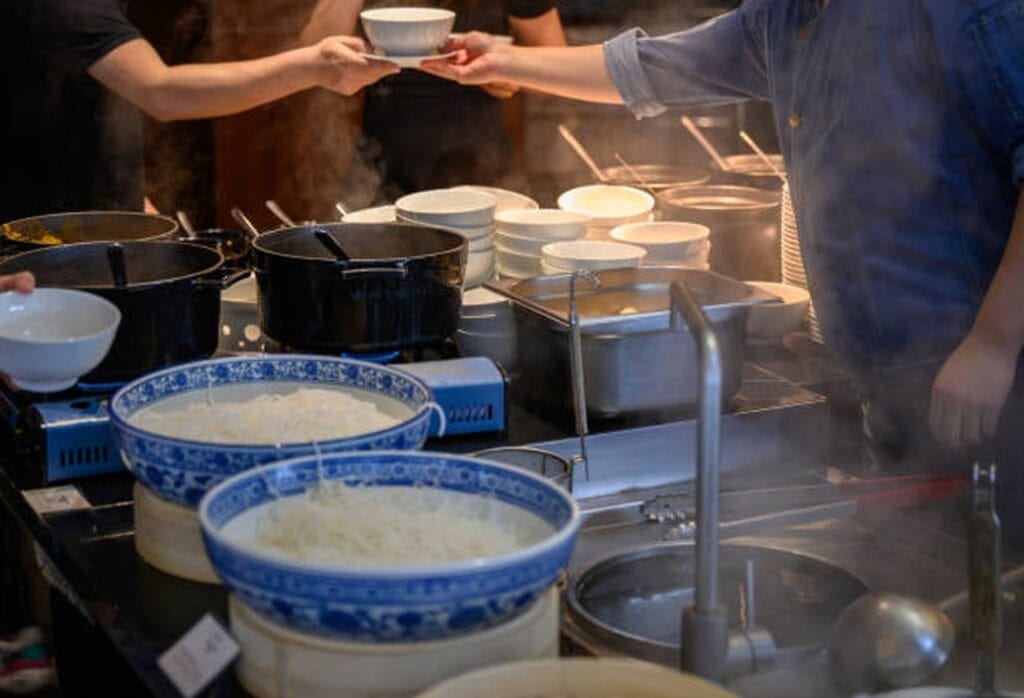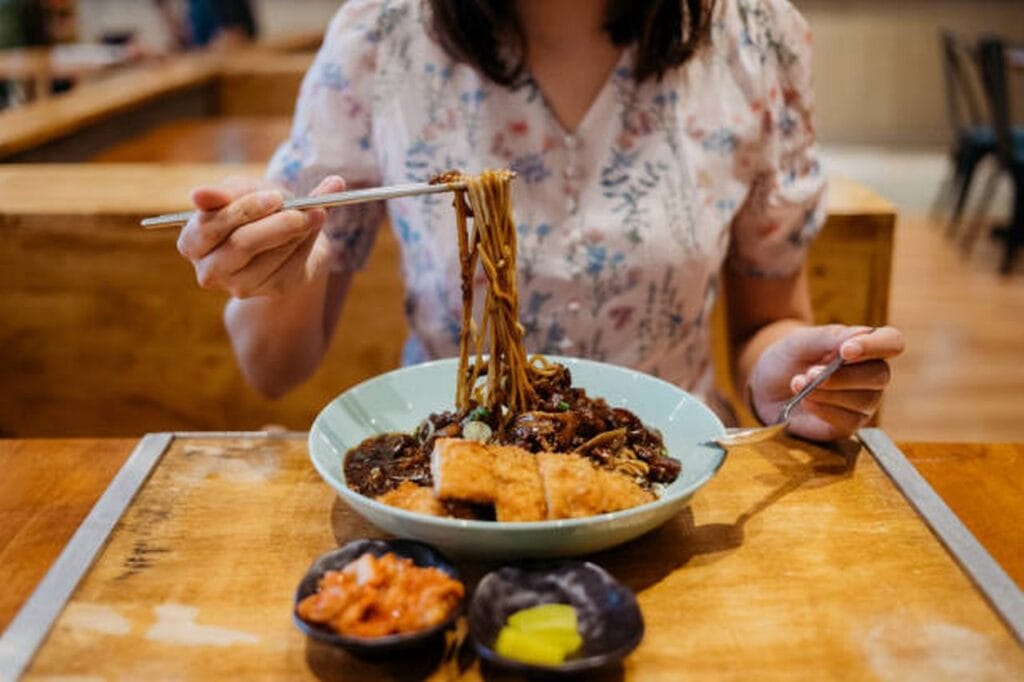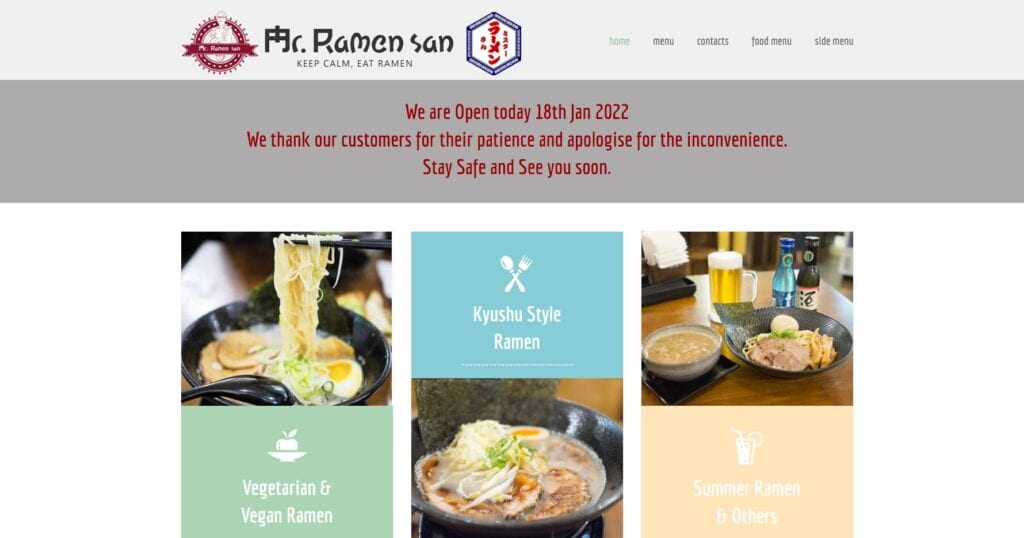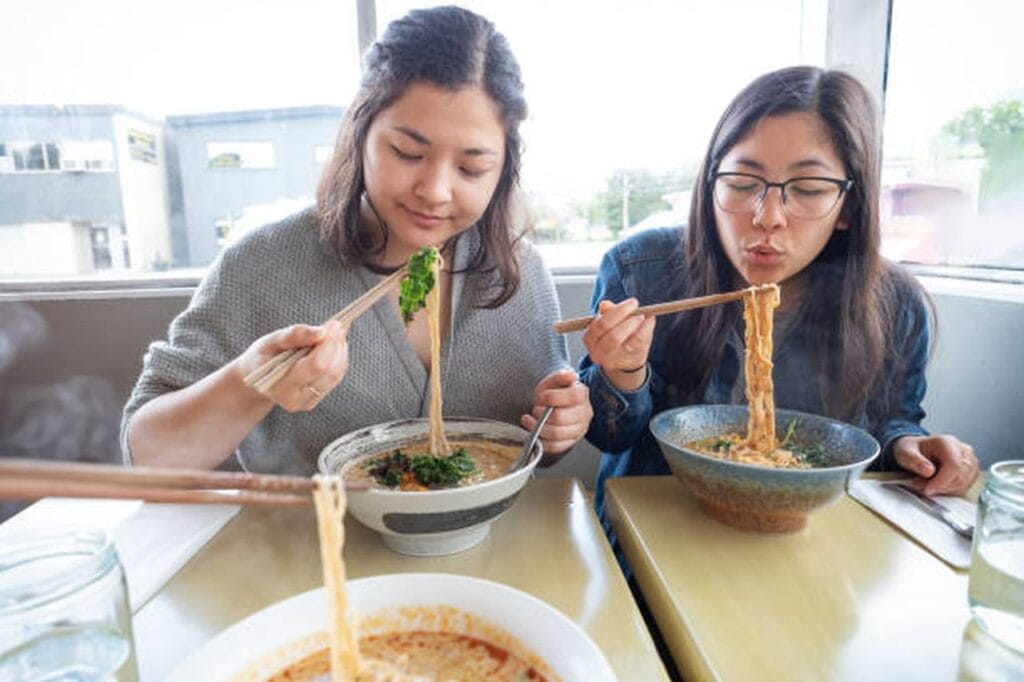During Melbourne's notoriously cold winters, the only thing better than soup is soup with noodles. It offers your bowl the proper weight to protect your ribs from the cold while the soup does its magic.
We've scoured the city for the best noodle soups in their class, crisscrossing international borders to warm you from the cockles to the crown, whether you're craving the hot-numbing zing of Sichuan-pepper laced Chongqing noodles or the earthy depths of pho. These are our top recommendations.
Noodles, noodles, noodles! Sometimes it feels like the ultimate comfort food is a giant dish of noodles. What makes excellent noodles? We believe that the best noodles are created by hand. They must also be cooked to perfection and not overcooked. Noodle dishes require fresh, high-quality ingredients, including good cuts of meat.
Here are our picks for the best noodle eateries in Melbourne.
11 Best Noodle Restaurants In Melbourne
Beautiful
Bowltiful delivers the Chinese-Muslim style of beef noodles in the most authentic way imaginable. Choose from nine different shapes and thicknesses of hand-pulled noodles to go with any of the eight offered dishes.
Noodle soups include beef and lamb offal, while dry noodle dishes include ground bean pastes, eggy tomato, and a garlic-bomb sauce. When the gluten in the wheat is worked so hard that it produces a bouncy, chewy single noodle, it is a sign of a fantastic hand-pulled noodle, as is the case at Bowltiful.
If you choose the thickest noodle, be warned: it's delicious, but you'll need to be quick with your chopsticks because it's as thick as a credit card, which makes for messy eating and could result in a massive splash-back.
Tina's Noodle Kitchen
Tina's Noodle Kitchen is a CBD noodle shop owned by Tina Li and part of the Dainty Sichuan group. If you're familiar with the original Dainty Sichuan restaurants, you'll know that these guys aren't afraid of the heat. So grab an icy cold glass of water and get ready for some amazing Sichuan-style chilli heat.
Tina's noodle soups are worth the wait, according to the lunchtime lines at the CBD store. Once you've found a seat, though, the big bowls of still-simmering noodles slathered with chilli oil will arrive nearly as soon as you get your drink.
Don't be put off by the unusual ingredients; the ruffles of black mushroom and konjac jelly are both highly healthful traditional ingredients—all the more reason to indulge in their famously spicy fried chicken.
Lanzhou Beef Noodle
Melbourne has always had a thing for carbohydrates, whether it be in the form of rice, pasta, or injera, but the humble bowl of noodles is currently in vogue thanks to Lanzhou Beef Noodle.
You might not have noticed, but Lanzhou Beef Noodle shops have been popping up all over Melbourne's universities. The next generation of workers' psyches and tummies are being fed by an army of diligent noodle-pullers at Melbourne University, RMIT, and Monash University.
Although it is the newest, the CBD location's interior is unremarkable. As you pass by the entrance to the cashier, you notice an accessible refrigerator chamber filled with delectable snacks and side dishes that tempt your urge to make an impulsive purchase.
Alongside bubble cup sealed containers of house-made drinks like sweet teas or juices with goji berries and winter melon floating in them are bowls of tea eggs priced per plate and strips of thinly sliced marinated beef, spicy pig's ears salad, braised chicken feet, garlicky cucumbers, corn cobs, and other foods.
If it's your first time, get ready for sensory overload, but have your order ready when you approach the counter or you'll snarl up the place's well-oiled machinery in less than ten seconds.
Before you even go snack shopping, you can select from braised beef noodles, spicy noodles, pickled cabbage noodles, or dry noodles from the menus that are presented in the front pane.
The staff will ask you about your prefered noodles (from extra thin to wide), if you prefer it traditionally spicy or toned down, and whether you want coriander and spring onions on top. Don't be put off by the free-flowing Mandarin; all of the staff speak excellent English.
The next step is to choose a seat, if any are available, and wait after receiving a number. Lanzhou Beef Noodle diners follow the standard operating procedure of eating, leaving, and then re-entering the restaurant to make space for the following hungry individual who will take your seat.
But the quality of the noodles is not diminished by the mediocre service. In the open kitchen, you can see the noodle puller pulling noodles to order with arms that are muscled out of timber and as broad as tree trunks.
He uses each finger to roll out a precisely practised quantity of dough, creating noodles of various size and shapes that are then cooked in a pot of boiling water before being assembled into your bowl by a line of workers.
Someone adds the broth, spices, and garnish before someone else adds the appropriate protein and brings the dish to your table. In the course of five minutes, everything happens.
The greatest hand-pulled noodles we've ever had in Melbourne are these. They come in an incredibly long string with the perfect texture and just-cooked bite, making you slurp. Even if you consider yourself a chopsticks pro, if you intend to eat here, avoid wearing a white shirt.
The humble carbohydrate is the main attraction, but each variation is rich and complex. Although the width of the noodles cannot be altered when using dry noodles, there is a vegan alternative that is worthwhile to take into account. You won't need the vinegar or the chilli oil that is on the table.
With the most expensive bowl of noodles costing $12.80, Lanzhou Beef Noodle has disproven the Iron Triangle theory by showing that it is possible to get something nice, quick, and affordable.
Mr Ramen San
As the CBD's remaining vintage arcades and food courts are encircled by glassy "dining precincts" and international competitors, we are left wondering if they are on borrowed time. Really, we hope not.
The hard, typically family-run businesses within have long satisfied the bellies of CBD employees for the least amount of money, from hot boat noodles and sour pig fried rice in the '90s chic Paramount Food Court to bain-maries filled of real Padang food at Tivoli Arcade.
Another go-to spot is MidCity Arcade on Bourke Street, which is well-known for the dumpling establishment Shandong Mama and where the amusingly named Mr Ramen San, a cosy restaurant serving a selection of the best noodles in city, is located.
Mr. Ramen San's bowls are flavorful while remaining light enough for everyday eating, in contrast to hyped tonkatsu restaurants like Hakata Gensuke and Ippudo, which market themselves on ultra-concise, thick soups.
The 10-hour pork bone broth has a gelatinous mass that glides across the spoon rather than sticking, and it is silky and creamy without being heavy. This lighter tonkatsu is best served with thin, bite-sized wheat noodles made in-house, along with sliced spring onions, pickled bamboo shoots, seaweed, and a jammy soy egg as standard toppings.
From whence, you can choose between the traditional thinly sliced chashu, which is a mixture of pliable fat and charred meat, and other options like miso-simmered beef, spicy chicken mince, prawns, and even a "vegan chashu" that mostly tastes like the Devon ham we used to put in our elementary school sandwiches.
This is a rare bowl of ramen with realistic serving sizes that is deeply filling without knocking you out, and free kae-dama (additional noodles) caters to the gluttons.
Therefore, Mr. Ramen San does make some delectable ramen. However, if you'll excuse us, maze soba, a soupless, saucy mixed noodle that lovers of Zha Jiang Mian and its Korean black bean cousin, jajangmyeon, will adore, is the cuisine you should come here for.
A plethora of ingredients, including minced garlic and chicken, roast pork, powdered dry bonito, chives, and spring onions, are spread over a bed of thicker, chewier wheat noodles, all of which are supported by a rich base sauce made of soy and pork fat.
The bold combination of three protein sources in one bowl produces a fiercely, addictively savoury result when combined with an onsen egg that is shining and a swirl of chilli oil. You are provided with a squirt bottle of rice vinegar to zap the earthy noodle gravy into a second, equally delicious life halfway through to prevent umami fatigue.
Nobody goes outside for ramen in the hopes of achieving balance. The variety of sides includes everything from delectable, light veggie gyoza in paper-thin wrapping to a cool salad of edible mushrooms, wood ear, and enoki mushrooms marinated in sweet soy sauce with hints of mirin.
If there isn't a line out the door, you could perhaps prefer to linger over sips of sake, umeshu, or ice-cold draught Sapporo during busy hours. Otherwise, it's strictly gulp down and dash.
Even the wood-hugged walls covered in coathangers, Totoro posters, and vintage advertisements feel transported rather than kitschy despite the decor's subtle emulation of a typical Tokyo ramen shop. You're likely to experience a feeling of security and ease while stuffing your cheeks full of noodles that no brilliant new point could ever provide.
Shimbashi Soba
Shimbashi is most renowned for their cold dipping soba, but their soups are also delicious. Each day, organic Tasmanian buckwheat is ground on-site and converted into noodles before each service, resulting in a delightfully chewy and nutritious noodle.
The sansai soba is a vegetarian option, with soba soaked in a light soy-based broth and topped with a variety of cooked veggies such as napa cabbage, seaweed, and Asian mushrooms.
Dodee Padang
The fourth store owned by the family, Somporn Phosri, imports Dodee Padang from Sydney. He thought that after capturing the hearts and mouths of Thai people in Sydney, it was time to conquer Melbourne. The 150-seater, which is colourful, low-tech, and community-driven, is crammed with Thai locals and is tucked away in the hotel's basement off Little Collins Street.
The staff and visitors speak English as their first language, but the service is just as friendly and polite in any other language. Just remember to portray when ordering because the '90s music will be blaring over the speaker systems from Celine, Mariah, and the Backstreet Boys. Thai cover bands occasionally play their prefered tunes. We assume you like the music of Coldplay.
The traditional tom yum noodle dish features heaping spoonfuls of fried garlic and crunchy wonton strips in a clear, pleasantly porky, hot-and-sour broth. Each can be customised with a choice of seven different kinds of noodles, including glass, rice, instant, and supersized for those with a large appetite. Toppings range from seafood to soft pork bone.
Every table has caddies filled with chiles in fish sauce, chilli powder, vinegar, and pure sugar to customise each dish to reflect your reality. With cautionary titles like "devil," "lava," "super volcano," and even "supernova," competitive friends can be observed competing on heat levels, tolerating chilli thresholds up to seven, which turns the normally transparent soup opaque.
Be prepared for sweats, chilli hallucinations, and Johnny Cash if you decide to order. The staff does well to question your bold choices, occasionally stating that the food is "Thai spicy" and they are able to only handle a level three chilliness.
Less common but no less delicious are tubs of rice drenched in the identical tom yum soup with a comparable assortment of toppings. A complete menu is also available the whole day, but it is advised that visitors come in clusters.
A punchy Nam Jim jaew dipping sauce is served with thin, marinated slices of grilled pig neck; strips of marinated, air-dried, fried beef are similar to jerky; and curries and son tums (green papaya salads) are as spicy as those in north-east Thailand.
Dishes like gelatinous, soft-cooked tendon stir-fried with chilli and holy basil that go well with rice and are best shared family-style due to the humming of spice will be served to individuals who are brave enough to try the specials.
Dodee Paidang is Melbourne's answer to the increasing number of homogenised, pan-Asian cafes that are springing up on each and every nook and offering frightfully similar menus. Other than being unapologetically Thai, it does not adhere to any rules. We commend Dodge for not catering to a western palate because it is proud of its origins, courteous in its service, and delicious in every bite.
Mensousai Mugen
They may be called ramen, but these noodle-heads are everything but. If you're looking for a break from the traditional pork-heavy ramens that may leave you comatose, this delicate soba dish is a great option.
The thick ramen noodles are replaced with thin, house-made wavy noodles that sit in a clear yet flavorful chicken broth seasoned with pink Himalayan salt and served with soft pieces of chicken breast, house-made chicken meatballs, bamboo shoots, and spring onion.
If you want, add a marinated egg for a bit of richness. Oishi!
Phở Nom
The frequent complaint about being in the CBD is that there is no good pho. That's where Pho Nom comes in to save the day. Chef Jerry Mai has not only built two stores in the city, serving wonderfully balanced broths that have been cooking for more than 24 hours, but she also utilises Warialda cattle and Glenloth chickens as the foundation of her recipes, assuring you of the provenance of your meat.
The Pho Saigon is made with a rich and clean beef broth, slippery rice noodles, soft-cooked brisket slices, rare beef, and beef balls. You can also customise your bowl with fresh Thai basil, bean sprouts, sliced chilis, and lemon wedges from a station. That can't possibly go wrong.
Grandma Noodle
Grandma Noodle is a global Chongqing chain, yet the noodles are made with care and consistency. A variety of chiles and spices are cooked and added to the rich stock that forms the foundation of this deceptively sophisticated bowl of fragrant noodles.
Sichuan peppercorns provide the distinct numbing sensation associated with Chongqing cuisine. This bowl does not include any meats, yet the hot and savoury soup strikes all of your taste buds and leaves you wanting more.
Dainty Noodle Express
Be aware of your inner thoughts. The intestines, or "chitterlings," get a poor record for their odour, although this is only because they aren't cleansed thoroughly (yeah, that is what you think it is).
However, these have been meticulously cleaned to produce a braised, fatty cut of beef that pairs well with the sweet spices and thick mung bean noodles in this hot and sour broth topped with fried soybeans. Be receptive to new ideas and experiences. One of two things could happen: you either like it or you really like it.
Soi 38
What if we told you the best boat noodles in Melbourne could be found in a parking lot? So, you should give it a shot and see whether you like it. Soi 38 serves only four unique dishes, all of which can be customised to your liking by adding or subtracting ingredients from the soup in the tableside caddy.
The beef boat noodles with their sweet and savoury spices are our favourite. Glass noodles or vermicelli work well for soaking up the rich broth, but you can't go wrong with any of the other accompaniments.
FAQs About Melbourne Restaurants
There are approximately 350 different types of pasta around the world — and about four times that many names for them! For example, due to its shape, farfalle pasta is often called “butterfly" or “bowtie" pasta.
Cooks use different shapes and sizes of pasta for different purposes. For example, different shapes hold different sauces better than others.
Some cooks say thin pasta, such as angel hair, should be served with thin sauces, while thicker sauces work better with thicker, heavier pasta. People often pair flat pasta with cream sauces, while tomato sauces cling better to round pasta.
The oldest evidence of noodles was from 4,000 years ago in China. In 2005, archaeologists reported finding an earthenware bowl that contained 4000-year-old noodles at the Lajia archaeological site.
These noodles were said to resemble lamina, a type of Chinese noodle. Analyzing the husk phytoliths and starch grains present in the sediment associated with the noodles, they were identified as millet belonging to Panicum miliaceum and Setaria italica.
However, other researchers cast doubt that Lajia's noodles were made from specifically millet: it is difficult to make pure millet noodles, it is unclear whether the analysed residue was directly derived from Lajia's noodles themselves, starch morphology after cooking shows distinctive alterations that do not fit with Lajia's noodles, and it is uncertain whether the starch-like grains from Laijia's noodles are starch as they show some non-starch characteristics.
The chemical composition, culinary and sensory attributes of the noodles were investigated. The protein, fat, ash, crude fiber, moisture and calorific values of the flour noodles ranged from 4.76 to 0.33%, 0.35 to 0.57%, 0.83 to 0.57%, 0.53 to 0.57%, 8.03 to 0.15% and 349.51 to 355.81 kcal/100 g respectively.
Noodles and pasta differ primarily because of their ingredients and the type of processing involved, Kaminska says. Noodles are usually made with flour milled from common wheat. Pasta is processed from durum semolina, which is coarser than typical flour. However, that difference is not always so cut and dried.
People get egg noodles and ramen noodles mixed up because the process of making these noodles are very similar to each other. The only real difference between their recipes is that ramen noodles use alkalised water (or kansui) to form the dough. Their color and texture are almost identical.
Conclusion
The ultimate comfort food is a giant dish of noodles. From Sichuan-pepper laced Chongqing noodles to the earthy depths of pho, these are our top recommendations. It offers your bowl the proper weight to protect your ribs from the cold while the soup does its magic. Tina's Noodle Kitchen The humble bowl of noodles is currently in vogue at Melbourne University, RMIT and Monash University.
The quality of the noodles is not diminished by the mediocre service provided by the staff. The greatest noodles we've ever had in Melbourne are these hand-pulled noodles. Lanzhou Beef Noodle has disproven the Iron Triangle theory by showing that it is possible to get something nice, quick, and affordable. Mr Ramen San's bowls are flavorful while remaining light enough for everyday eating. The 10-hour pork bone broth has a gelatinous mass that glides across the spoon rather than sticking, and is silky and creamy without being heavy.
Mr Ramen San is a rare bowl of ramen with realistic serving sizes that is deeply filling without knocking you out. Free kae-dama (additional noodles) caters to the gluttons. The bold combination of three protein sources in one bowl produces a fiercely, addictively savoury result. The 150-seater eatery is crammed with Thai locals and the staff speak English as their first language. Toppings range from seafood to soft pork bone and macaroni bones.
He thought that after capturing the hearts and mouths of Thai people in Sydney, it was time to conquer Melbourne. Each can be customised with a choice of seven different kinds of noodles, including glass, rice, instant, and supersized for those with a large appetite. Dodee Paidang is Melbourne's answer to the increasing number of homogenised, pan-Asian cafes that are springing up on each and every nook. Other than being unapologetically Thai, it does not adhere to any rules. Menousai Mugen is a break from the traditional pork-heavy ramens that may leave you comatose.
Pho Nom serves wonderfully balanced broths that have been cooking for more than 24 hours. The thick ramen noodles are replaced with thin, house-made wavy noodles that sit in a clear yet flavorful chicken broth seasoned with pink Himalayan salt and served with soft pieces of chicken breast, house-made chicken meatballs, bamboo shoots, and spring onion. The Pho Saigon is made with a rich and clean beef broth and slippery rice noodles. Grandma Noodle is a global Chongqing chain, yet the noodles are made with care and consistency. Soi 38 serves only four unique dishes, all of which can be customised to your liking by adding or subtracting ingredients.
Content Summary
- You might not have noticed, but Lanzhou Beef Noodle shops have been popping up all over Melbourne's universities.
- The next generation of workers' psyches and tummies are being fed by an army of diligent noodle-pullers at Melbourne University, RMIT, and Monash University.
- With the most expensive bowl of noodles costing $12.80, Lanzhou Beef Noodle has disproven the Iron Triangle theory by showing that it is possible to get something nice, quick, and affordable.
- Dodee Padang The fourth store owned by the family, Somporn Phosri, imports Dodee Padang from Sydney.
- Dodee Paidang is Melbourne's answer to the increasing number of homogenised, pan-Asian cafes that are springing up on each and every nook and offering frightfully similar menus.
- Phở Nom The frequent complaint about being in the CBD is that there is no good pho.
- The Pho Saigon is made with a rich and clean beef broth, slippery rice noodles, soft-cooked brisket slices, rare beef, and beef balls.



